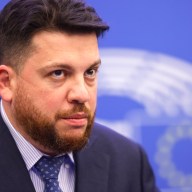 Filmmaker Ned Benson’s first feature happens to be the three-five, film hour-plus saga “The Disappearance of Eleanor Rigby.”
Filmmaker Ned Benson’s first feature happens to be the three-five, film hour-plus saga “The Disappearance of Eleanor Rigby.”
Credit: Getty Images
That “The Disappearance of Eleanor Rigby” is a drama spanning three films and over five hours is Jessica Chastain’s fault. Writer-director Ned Benson met the actress when they were both just starting out. He gave her the original script, which was at that stage a standard-length drama about a man, Connor (James McAvoy in the film), whose titular, named-after-the-Beatles-song wife takes off to an undisclosed location months after the death of their child. The film covered his perspective and his life, into which Eleanor only made sporadic, cameo appearances.
“She kept asking me questions about the character of Eleanor Rigby. That gave me the impetus to try something, which became her story,” Benson recalls. He decided to make it two separate movies: one about him, subtitled “Him,” and one about her, “Her.” It made sense anyway. “I wanted to write a love story. There’s no better way to write a love story than to show both perspectives of a relationship. It became this film about subjectivity in relationships and showing both sides.”
The result was a 223-page script. “I was a first time director. [Chastain] had done the Malick movie [“The Tree of Life”], but hadn’t really broken yet. And Cassandra [Kulukundis] is a young producer. So it’s this rag-tag team trying to make this impossible movie. People were like, “Good luck! [Laughs] Sure you’re going to make a two-part movie!”
Cut to now and not only does there exist two movies, which played last year’s Toronto International Film Festival, but a third: “Them,” which mashes together the two parts into a more digestible, restless audience-friendly feature. That came reluctantly. “It’s funny, because in the process of trying to make this movie, people were like, ‘Maybe you should combine the script.’ So were agents, sales reps, even festival programmers,” Benson says. “Jessica, Cassandra and I were always so steadfast of what this needed to be. If we hadn’t been, I think we would have lost what’s really special about the project.”
But after its hit run at Toronto, he sat down with his editor, Kristina Boden. “We asked, ‘Should we see if this is even possible?’ We had this two-part, three-hour and 10 minute film. There are certain people would go see that. But most of those people live in New York or Los Angeles. We wondered if there was a version of this film that is two hours and can play to a broader audience, to people who don’t necessarily want to go see three hours and 10 minutes of a movie. We tried and we found it, in a month.”
Even in the wake of the wild success of another experimental, epic narrative — Richard Linklater’s “Boyhood” — Benson is glad “Eleanor Rigby” exists in multiple forms. “It allows people to see how they want to see it, because I’m not going to tell you how to see it,” he says. “I want to allow audiences to have their own subjective experiences with it.”
Piecing it together wasn’t easy, though. “Her” and “Him” each have a different look. “I created a color space and a visual rhythm for ‘Him.’ It’s a cooler more fluid, static feeling, which reflects his personality and emotions,” he explains. “The same goes for ‘Her.’ It’s much warmer and much more loose, which reflects her inner state and the emotional tenor of where she’s at.”
Then there’s the trickier problem of how to stitch together two films never intended to be attached. “It was tricky,” Benson says, “because we didn’t write that third film. We were using pre-existing footage. We realized we were making an entirely new movie. There was a new rhythm that has to be found; it’s a new organism.”
 Jessica Chastain (with James McAvoy over her shoulder) played a key role in the formation of “The Disappearance of Eleanor Rigby.”
Jessica Chastain (with James McAvoy over her shoulder) played a key role in the formation of “The Disappearance of Eleanor Rigby.”
Credit: The Weinstein Company
The other big issue is that “Her” and “Him” are subjective portrayals of the same overall story, complete with key scenes written and shot two different ways. Does putting a scene from “Him” over the similar one in “Her” mean that’s the “correct” version?
“’Them’ is someone from the outside looking in on their relationship — not necessarily getting his version of it or her version of it,” he states. There were a lot of reasons he chose which version to go in “Them.” “One was I wanted to find the scenes that were the most emotionally resonant. But some were as silly as being about production and costume design. There were scenes where James is wearing a white shirt in ‘Her’ and a blue shirt in ‘Him.’ I needed to follow continuity. The scene where she shows up at the bar and they go off in the car, I had to use one version because I couldn’t ruin the continuity.”
He doesn’t feel he needed to choose based on performance, though. “The work done by both is so beautiful, but I didn’t have to feel awful about choosing one over the other. It wasn’t a horrible ‘Sophie’s Choice,’ where I was losing the best scene because of continuity. I was like, ‘This is amazing, that is amazing.’ Both scenes still exist in ‘Him’ or ‘Her.’”
Another challenge Benson found as a first-time feature filmmaker was having to direct some legends, namely Isabelle Huppert and William Hurt, who play Eleanor’s parents, Ciaran Hinds, who plays Connor’s father, and Viola Davis, who plays Eleanor’s sarcastic, world-weary New School professor, when Eleanor decides to treat her anxieties by going back to school.
“You have all this anxiety and stress leading up to making the thing, then all of a sudden you’re making it and you’re like, ‘Oh my god, I’m making it” he says. “You don’t have time to be neurotic about it because you’re creatively overwhelmed.”
He found the experience more surreal than scary. “That first day, when I was walking into direct my first film and I’m looking at the call sheet and I was like, ‘Who? What?’” He suddenly found himself on Huppert’s first night in New York City, where the film was shot, having a three-hour dinner with the famous thespian. “She talked about working with Claude Chabrol and [Michael] Haneke, and I was just listening. She was like, ‘What I liked about Chabrol was he shut up. He didn’t talk too much.’ But you could see her deference to Chabrol. The same with William. It was about knowing when to shut up with people like that, with people like Viola, with people like Ciaran. It’s knowing when to insert yourself in and give a note.”
He remembers one night that didn’t go so smoothly. He was shooting a scene with Hurt and Chastain. The runway at La Guardia had been shifted, so planes were flying overhead every two minutes. The crickets wouldn’t shut up, forcing P.A.s to jump into the bushes to shut them up. The light had changed.
“All these things were going wrong. I sat down while we were watching to change a setup, and William came up behind me and said, ‘This is hard. But you’re doing good,’” he recalls, laughing. “When you have people like that who give you their trust — and I don’t know why they gave me their trust — but when they do, you feel invincible.”
Also see our interview with “The Disappearance of Eleanor Rigby” star Jessica Chastain.
Follow Matt Prigge on Twitter @mattprigge
















